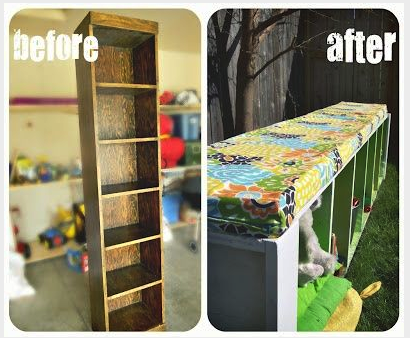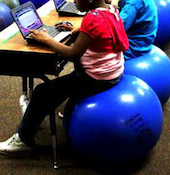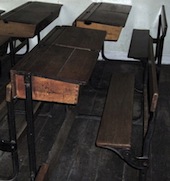Why change the classroom layout? Why change and rearrange the classroom furniture?
Our classrooms are often so stayed and old fashioned, learners sit in rows of old fashioned desks. What type of learning impression does your learning space evoke? Research indicates that learners learn better when they discuss information working with other class members to find a solution. The layout of our classrooms, and maybe our teaching strategies, may not allow for this interactive way of learning.
Ask yourself: How has the space you teach in changed over the years? Does it appeal to the modern child? Am I making school meaningful, relevant and interesting for the children who visit my learning spaces every school day?
 Edward Baum (2008), a chemistry professor at Grand Valley State University, Allendale, Michigan explains that it is to the learner's advantage to learn in a collaborative environment. He expresses that the learners always perform better in the collaborative learning areas of the general chemistry venue compared to the lecture sections. Baum goes on to say that this has been shown at several universities including Wisconsin, Berkeley and Georgetown.
Edward Baum (2008), a chemistry professor at Grand Valley State University, Allendale, Michigan explains that it is to the learner's advantage to learn in a collaborative environment. He expresses that the learners always perform better in the collaborative learning areas of the general chemistry venue compared to the lecture sections. Baum goes on to say that this has been shown at several universities including Wisconsin, Berkeley and Georgetown.
The League for Innovation in the Community College (cited in Herman Miller, inc 2006) identified outcomes for twenty-first century learners. These outcomes included communication skills, diversity and pluralism, critical thinking and problem solving,
furn collaboration classroom full of children small.jpg
interpersonal skills including teamwork, relationship management, conflict resolutions, workplace skills, and personal skills for management of change, learning to learn, and personal responsibility. This once again emphasizes collaboration and interaction. To effectively achieve collaborative learning environments we should consider the type of furniture we use in a classroom or in other learning spaces.
Yes, our teaching strategies, the classroom wall content and interest or experimental areas in the classroom are important, and have a positive effect on the learners' learning. I agree, however now, I'd like to focus on the furniture we use in the spaces, to make the learning spaces more collaborative and "learner-friendly". I don't think we always think about our classroom furniture, we just take it for granted.
Steelcase, University of Michigan Case Study shows the change in teaching strategies and this is impacting on classroom layout and design.
Making furnishing changes or lack thereof may be due to budgeting constraints, but as a teacher I think we should always be questioning, exploring and finding out better ways to educate the learners in our care. In the video "A day in a VEF Flexible Furniture classroom" ideas are given as to how a venue can be used by rearranging the furniture encouraging and allowing collaborative learning to take place more easily than when desks are postioned in just straight rows. Watch this video on how to increase potential of your classroom furniture and students.
In "What Is the Collaborative Classroom?" by Tinzmann, Jones, Fennimore, Bakker, Fine and Pierce (1990) suggested that the way learners learn is changing. They suggest that learners are knowledgeable, self-determined strategic and empathetic thinkers. They also state that research indicates successful learning involves an interaction of the learner, the materials, the teacher, and the context. Think about re-arrangiung your classroom furniture, and having different areas for learners to work. Do you need a full class of desks for teacher-centred teaching? Could you use groups within a class? How does the furniture layout of your classroom relate to your teaching strategy? Even High school teachers need to re-consider a lecture-type appropiate, to relate better to the changing learners.
Anuradha A. Gokhale (1995) expresses that for collaborative learning to be effective, the educator must view teaching as a process of developing and enhancing students' ability to learn. The educator's role is not to transmit information, but to serve as a facilitator for learning. This involves creating and managing meaningful learning experiences and stimulating students' thinking through real world problems. Redesigning a teaching space into a learning space will assist in a teacher becoming a better collaborative learning educator.
Once the decision has been made to make changes, begin to plan carefully. We, as teachers, may want to change our learning space, but we are not sure where to start. It also does not have to be costly.
Watch "Remake Your Class: Part 1 Planning for a Collaborative Learning Environment" and get some initial ideas to consider when planning to do a learning space make-over.
"Remake Your Class: Part 2: Building a Collaborative Learning Environment" shows how the classroom was transformed, with a small budget, and involving the parents, learners and local community.
The layout of the venue where the lesson activities will take place should be conducive to encouraging interaction and engagement, therefore the furniture would play an important role in allowing learning to interact easily with each other. The colour of the room would also affect the atmosphere, also see blog "Colours for the Classroom"
In "Remake Your Class: Part 3: Exploring a Collaborative Learning Environment" note how the room has been transformed for easier flow, and better teaching resources and more effective learning spaces.
A study by Herman Miller, Inc (2006) found that co-operative learning methods, even in higher education benefitted learners in the acquistion of knowledge, knowledge retention, accuracy, higher-levels of reasoning and greater creativity when solving problems. They suggest that classroom design influences engagement and interaction of the learners, through active learning and that this involvement improves retention of information.
 The learners' ability and skill to become a self directed learner and to solve problems in collaborative manner is strongly influenced by the classroom design. Jeremy Hall (2002) found that participatory learning was much for effective for retention of knowledge rather than passive learning. He noted that passive learning, such as lecturing as a teaching method had a learner retention of 5% of the knowledge taught, reading 10%, audio visual 20% and demonstration of knowledge 30% overall retention, while particpatory learning, such as group discussion had 50% retention level, practice by doing 75% and teaching others had a 90% retention level. So allowing learners to collaborate and interact was massively advantagous to children remembering what was taught. Therefor furnishings would impact on how easily learners can move around the room, collaborate and interact with others. Consider redesigning the layout of your classroom furniture.
The learners' ability and skill to become a self directed learner and to solve problems in collaborative manner is strongly influenced by the classroom design. Jeremy Hall (2002) found that participatory learning was much for effective for retention of knowledge rather than passive learning. He noted that passive learning, such as lecturing as a teaching method had a learner retention of 5% of the knowledge taught, reading 10%, audio visual 20% and demonstration of knowledge 30% overall retention, while particpatory learning, such as group discussion had 50% retention level, practice by doing 75% and teaching others had a 90% retention level. So allowing learners to collaborate and interact was massively advantagous to children remembering what was taught. Therefor furnishings would impact on how easily learners can move around the room, collaborate and interact with others. Consider redesigning the layout of your classroom furniture.
A collaborative space should be flexible and allow diversity, for example for use with or without technology. The space should also be able to be adapted for both individual and group tasks.
When thinking about creating collaborative learning spaces, we need to ask ourselves, as educators a few questions.
- What is the main purpose for the space? (Individual time, interactive, collaborative working time or a mixture)
- Who will be using the space - consider the age of the learners
- How many learners would be using the space at a time?
- How many educators or teachers would be in the space?
The Furniture - Think about the type of furniture to be used in the learning space. Simmons, 1995 stated that colour in the learning environment provides an unthreatening environment that improves visual processing, reduces stress, and challenges brain development through visual stimulation/relationships and pattern seeking. Visual stimulation actually rewires the brain, making stronger connections while fostering visual thinking, problem solving, and creativity.
In the 2013 Herman Miller Student Video Contest, University of Ottawa students created a video about learning spaces. There are many ideas to consider and think about regarding furniture, lighting and layout, while watching this short clip. Consider what you would need to do at your school to make changes to create effective learning spaces? Click on the link: http://youtu.be/YYcnqY0bA_Y
When selecting furniture consider:
- How the space will be used - both Individual working and learning, as well as interactive, collaborative working and learning?
- What age group of children will be using the space?
- is the space enclosed and sperate or in an open common area?
- Is the furniture the correct size for the age group of children (hyounger children need smaller furniture)
The furniture needs to be practical, functional and ergonomically appropriate for the age group using the space
Be creative in thinking, when selecting the furniture. It should be versatile and easily movable, so the space can easily be converted for different uses. Movable furniture, helps us to create multifunctional learning spaces. By using furniture that can be easily moved around the options of how a room can be used increases, so the venue can be changed from group work to individual learning, to where a teacher- centered session takes place, but each would be an option. Learners must feel comfortable and free in this space, willing to take risks with others in a collaborative environment.
The age of the learners would influence furniture choices to be made.
Existing desks could become "movable furniture" by adding lockable casters (wheels) to the table legs. Look in school store-room and all classrooms they may be furniture that can be adapted slightly and then would be useful in a modern classroom.
 Unusual shaped desk tops could be created by purchasing larger sheets for wood, resin plastic or other material, that can be cut to the desired shape and then securely attached to the base of an existing school table.
Unusual shaped desk tops could be created by purchasing larger sheets for wood, resin plastic or other material, that can be cut to the desired shape and then securely attached to the base of an existing school table.
Larger desks for group work, can be created by using the bases of two old desks and places a large desk top onto the two old desks metal frames or wooden bases.
Seating arrangements
Both individual seating and group seating should be considered.Individual seating, should be comfortable and easily mobile, that a learner jay move the chair to a quieter area of the learning space to work on his / her own.
Groups seating may include individual chairs that can easily be moved together to form a group or may be couches which small groups could huddle on.
The colour considerations in this space is extremely important, see blog on colour Be careful of over-stimulation, but don't use boring colours, create a space that encourages learning.
Perhaps the old desks could be scrapped and the legs repainted or desk tops re-vanished to give them a new look as well. Consider repurpousing school furniture, instead of just spending money and buying new.
If you have old chairs with an "arm" desk, as shown in the picture, casters (wheels) could be placed on the chair's legs, and they could become ideal movable pieces of furniture for learners using tablets or other mobile devices.
Here is an exmple of how an old bookcase was turned into a storage and seating area - lovely idea of a classroom.

Always ask yourself are chairs really needed? Cushions or balls may also be considered for learners to sit on.

Have a look at this classroom video with unusual teaching space. There is not much collaboration nor much interaction. The seating arrangements shown in the video could be used, by yourself, to encourage debate among your staff members when brainstorming about the "new" look and feel of the room to be transformed. Here are other ideas of different types of classroom furniture.
Think of ways to use your existing school furniture to revamp it in practical manner e.g don't paint table tops as they get easily scratched - but painting table and chair legs could make a colourful and great improvement.
Think about rearranging the furniture to make it easier to move around.
Investigate whether there is available budget which could be used for furniture or furnishings to create interactive and collaborative learning environments for learners and teachers.
Look at this Australia company's website and see the ideas of different school furniture, from Flexible furniture. Smith System furniture gives ideas of traditional and modern classroom-type furniture.
The person who is going to work in the learnning space should take part in the discussions about the furniture change and how to make the room an effective learning environment.
The KI Education Furniture Solutions video shows the transformation of Pan American Academy Charter School in Philadelphia, Pennsylvania, USA. While watching be aware the use of colours in the floor tiles and even walls, the unusual desk shapes for creative desk arrangements, and the wheels on the tables and chairs for easy mobility. The positioning of the furniture also differs depending on the age group being taught.
E-learning Spaces
If this collaborative learning space, is an e-learning space, think about:
What technology would be used? What devices to be used? Will it be BYOD? (Tablets, laptops or notebooks) What the required teaching and learning school devices: Interactive whiteboards, response systems, etc.? Are they movable or non-movable?
- How are the devices connecting to the internet? Wifi? Landlines?
- Are there places where the devices can be safely charged?
- Do you want learners to be able to charge devices at school?
- Can the devices be stored safely and securely, near this area of learning when not required?
An important aspect to consider is how learners and educators will connect to the internet in these venues, and what technological devices will be able for use and whether it's also a bring your own device space. Infrastructure of the area Internet connectivity Facility to easily charge the many devices
Does your school allow learners to charge devices at school? (How many access points would be required?) Or is it the learner's responsibility to bring a charged device to school? You with school supply a limited number of access points for charging of to be used by learners? Will the devices be safe while they are being charged?
Schools are creating "e-learning spaces" or "learning studios" open space areas, these environments are to encourage learners to interact and engage in their learning with and without the use of technology.
Pes Jsu's Designing a Collaborative Classroom YouTube video provides much infomration and apsects that should be considered when creating a collaborative classroom.
A primary school video in "Getting creative in a Getting Creative in Canadian Classrooms with Samsung School" has interesting ideas of how to use tablets inside and out of the class with primary school children. If laptops or notebooks are used, learners would require desk spaces to place the device while working.
Create a personal security of device easily for each child, by transforming the old desks which have tip up lids and a storage compartment, by attaching a hasp and staple to the desk and lid, children could then have a padlock which secures the space for safe storage of their mobile devices when not in use.
If only tablets are to be used, desks may not be necessary as learners could hold the tablets (other mobile devices) or rest them on their laps.

RM Education depicts learning spaces of the future in a short video. Wow, learning in tose spaces will be different, engaging, collaborative and fun!
On my Pinterest account I have a board called "classroom-furniture, design, layout", there are many pins giving ideas about classroom furniture and layout.
Developing critical thinking and problem solving skills, builds skills learners would use for the rest of their lives. Anuradha A. Gokhale (1995) conducted research on how "Collaborative Learning Enhances Critical Thinking". The results of this research study, concluded that collaborative learning fosters the development of critical thinking through discussion, clarification of ideas, and evaluation of others' ideas. It also showed that if the purpose of instruction was not just to gain knowledge, but to develop and enhance critical-thinking and problem- solving skills, then collaborative learning is more beneficial. In an interactive, collaborative learning environment
Classroom design can help to develop skills for life and work beyond the classroom. Self-directed learning and collaborative problem solving are essential skills for success. Create environments that encourage learning
Changing the furniture is part of the solution, the other is adapting and changing the teaching methodology so that true collaborative, learner-engaged lessons are presented and allowed.
Watch this 1st Place Winner of the 2013 Herman Miller Student Video Contest about learning spaces. There is a lot of food for thought in this video clip and it could make interesting discussions around learning spaces in schools with younger children, and how we as teachers could make the learning spaces truly effective.
The teacher rules his / her classroom, as the teacher, you decide how the actual lesson will progress. Enjoy exploring furniture change, investigating how that will change and / or enhance your learners' learning and your teaching pedagogy as it evolves into a truly learner centred, collaborative learning space.
Additional Reading and Viewing
360.Steelcase. (online) Standford d.school Case Study (video) Retrieved from:
360.Steelcase (Online). Colleges put Steelcase LearnLab environments to the test. Something strange was happening in Ricardo Rodriguez's math class. Midterm Review Issue 52.
360.Steelcase (Sept 2007- online) A new learning curve. Steelcase LearnLabTM Environments
AdvEducation (2013, online) Making a Difference in Education with Samsung School
Australian Institute for Teaching and School Leadership Limited. (online) A Collaborative learning Space.
Cox, D. Learning Spaces (online) BizFurn Express. h
References:
360.Steelcase (online). University of Michigan: Case Study
AdvEducation (2013, online) Getting Creative in Canadian Classrooms with Samsung School.
Baum, E. (2008) Something strange was happening in Ricardo Rodriguez's math class. 360 Midterm Review. Issue 52. Steelcase, Inc.
Bedley, T. (online) Searching for an Off Task Student.
Remake Your Class: Part 1: Planning for a Collaborative Learning Environment
Edutopia (6 Aug 2013). Remake Your Class: Part 2: Building a Collaborative Learning Environment.
Edutopia (6 Aug 2013). Remake Your Class: Part 3: Exploring a Collaborative Learning Environment.
Fryer, W. (online) Collaborative Learning Spaces at Texas Tech University
Gokhale, A. A. (1995). Collaborative Learning Enhances Critical Thinking. Journal of Technology Education. Vol. 7, Number 1
Hall, J. (2002, updated 15 April 2012). The Learning Pyramid. Teaching Methods and Retention. Hall Marketing. London. England.
Herman Miller, Inc (2006) Rethinking the Classroom: Spaces Designed for Active and Engaged learning and Teaching. Education, Engagement. Herman Miller, inc. 2014.
Herbert, G. (13 May 2013) University of Ottawa. 2013 Herman Miller Student Video Contest [2nd Place]
Jsu P. (20 Aug 2012) Designing a Collaborative Classroom
KI Kinetwork. (Pub. 4 Jan 2013). KI Education Furniture Solutions Transform Pan American Academy Charter School
Lim, A. (uploaded 31 Jul 2011) A day in a VEF Flexible Furniture classroom (video) Victorian Educational Furniture.
RM Education (online) Learning spaces of the future.
Shoulder, T (13 May 2013) 1st Place - 2013 Herman Miller Student Video Contest.
Tinzmann, M.B., Jones, B.F., Fennimore, T.F. , Bakker, J. , Fine, C., and Pierce, J. (1990) What Is the Collaborative Classroom? New Learning and Thinking Curricula Require Collaboration. NCREL, Oak Brook.
VEF Flexible furniture (online). A day in a VEF Flexible Furniture classroom.
Image References:
Adapted - Explore, Read table "image - Found on Pinterest: newyoueyeme5.us
Bookshelf to seating transformation - before and after - Found on Pinterest: pin4fun6145.blogspot.com
Adapted - Yellow table layout - Found on pinterest, imgur.com Adapted from Current furniture - images http://imgur.com/a/uhRUT#42; http://imgur.com/a/uhRUT#43; http://imgur.com/a/uhRUT#51
Adapted "sitting on ball" from SecurEdge Blog, 7 Ways to Use Technology in the Classroom to enrich learning
Your thoughts:
Let me know if you enjoyed this information, leave a comment. If you would like me to do workshops with your staff, contact me on the Contact page.
I would love to hear your thoughts and ideas, email me on: karen@walstra.co.za or comment about this blog article "Classroom Furniture & Arrangement for learning and e-learning spaces";
Follow me on Twitter at @KarenWalstra






